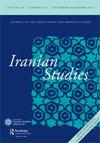萨法维德、阿富汗和伊朗的邮政系统
IF 0.9
4区 社会学
Q2 AREA STUDIES
引用次数: 0
摘要
在对1500年之前和1800年之后伊朗邮政系统的运作进行研究的同时,本文完全基于第一手资料,首次分析了1500年至1800年之间伊朗邮政系统的运作和特点。这样的研究使学者们能够更好地理解萨法维、阿夫沙里和伊朗土地上政府官员和个人之间的沟通功能。在这一时期,有两种信使:负责公务的快马信使(chapar)和负责公务和私人邮件的步行信使(shater s)。qased这个名称很少用来表示邮差。本文章由计算机程序翻译,如有差异,请以英文原文为准。
The Postal System in Safavid, Afsharid, and Zand Iran
Abstract While the functioning of the postal system in Iran before 1500 and after 1800 has been studied, this article analyzes, based entirely on primary sources, the operation and characteristics of the Iranian postal system between 1500 and 1800 for the very first time. Such a study enables scholars to better understand the functioning of communication between both government officials and private individuals in Safavid, Afshari, and Zand Iran. During this time, there were two types of messengers: express-mounted couriers ( chapar ) for official business and foot messengers ( shater s) for both official and private mail. The designation of qased was rarely used to denote mail foot messengers.
求助全文
通过发布文献求助,成功后即可免费获取论文全文。
去求助
来源期刊

Iranian Studies
Multiple-
自引率
0.00%
发文量
92
期刊介绍:
Iranian Studies is a peer-reviewed journal devoted to Iranian and Persian history, literature, and society, published on behalf of the Association for Iranian Studies . Its scope includes all areas of the world with a Persian or Iranian legacy, especially Iran, Afghanistan, Central Asia and the Caucasus, and northern India, and Iranians in the diaspora. It welcomes submissions in all disciplines.
 求助内容:
求助内容: 应助结果提醒方式:
应助结果提醒方式:


